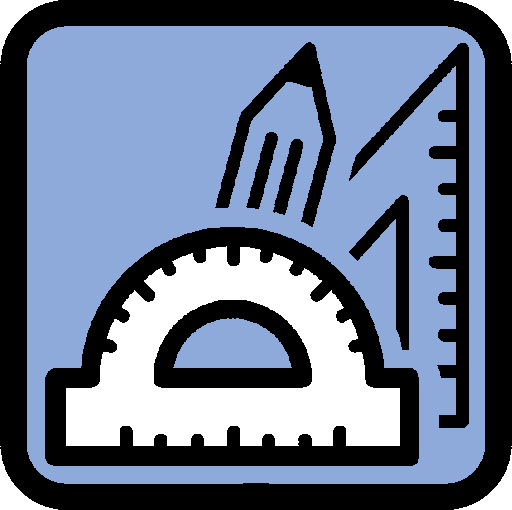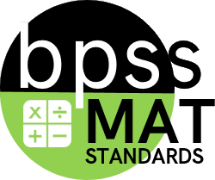MAT-05.GM  MAT-05.GM MAT-05.GM Domain  | (GM) Geometry and Measurement Learners will use visualization, spatial reasoning, and geometric modeling to investigate the characteristics of figures, perform transformations, and construct logical arguments.
|
Sub-Categories- (G) Geometry
Learners will compose and classify figures and shapes based on attributes and properties; represent and solve problems using a coordinate plane. - (M) Measurement
Learners will represent and calculate measurement data, including time, money, and geometric measurement, and convert like measurement units within a given system.
- (AV) Area and Volume
Learners will use visualization and spatial reasoning to solve problems involving the area, surface area, and volume of geometric figures. - (GF) Geometric Figures
Learners will use visualization, spatial reasoning, and geometric modeling to investigate the characteristics of figures, perform transformations, and construct logical arguments.
Calculation Method for DomainsDomains are larger groups of related standards. The Domain Grade is a calculation of all the related standards. Click on the standard name below each Domain to access the learning targets and rubrics/ proficiency scales
for individual standards within the domain. |
|
MAT-05.GM.G.01

|
5th Grade (MAT) Targeted Standard
(GM) Geometry and Measurement
(G) Geometry
Learners will compose and classify figures and shapes based on attributes and properties; represent and solve problems using a coordinate plane.
|
MAT-05.GM.G.01 Classify two-dimensional figures in a hierarchy based on properties.
 Proficiency Scale Proficiency Scale
Progressions
Two-Dimensional Shapes
- MAT-00.GM.G.01 Name shapes and identify them as two-dimensional (squares, circles, triangles, rectangles)regardless of their orientations or overall size.
- MAT-00.GM.G.03 Compare and classify two-dimensional shapes to describe their similarities, differences, and attributes (squares, circles, triangles, rectangles).
- MAT-01.GM.G.01 Name shapes and identify them as two-dimensional (trapezoids, rhombuses, pentagons, hexagons, octagons).
- MAT-01.GM.G.03 Determine geometric attributes of two-dimensional and three-dimensional shapes.
- MAT-02.GM.G.01 Identify two-dimensional shapes (parallelograms and quadrilaterals).
- MAT-02.GM.G.03 Compose geometric shapes having specified geometric attributes, such as a given number of edges, angles, faces, vertices, and/or sides.
- MAT-03.GM.G.01 In two-dimensional shapes, identify lines, angles (right, acute, obtuse), and perpendicular and parallel lines.
- MAT-03.GM.G.02 Sort quadrilaterals into categories based on attributes.
- MAT-04.GM.G.01 Identify, label, and draw points, lines, line segments, rays, and angles (right, acute, obtuse).
- MAT-04.GM.G.02 Classify two-dimensional figures based on the presence or absence of parallel or perpendicular lines or the presence or absence of angles of specified size.
- MAT-05.GM.G.01 Classify two-dimensional figures in a hierarchy based on properties.
- MAT-10.GM.01 Know precise definitions of angle, circle, perpendicular line, parallel line, and line segment based on the undefined notions of point, line, and plane.
- MAT-10.GM.09 Prove and apply theorems about lines and angles.
- MAT-10.GM.10 Prove and apply theorems about triangles.
- MAT-10.GM.11 Prove and apply theorems about parallelograms.
- MAT-10.GM.34 Identify the shapes of two-dimensional cross-sections of three-dimensional objects and identify three-dimensional objects generated by rotations of two-dimensional objects.
|
|
MAT-05.GM.G.02

|
5th Grade (MAT) Targeted Standard
(GM) Geometry and Measurement
(G) Geometry
Learners will compose and classify figures and shapes based on attributes and properties; represent and solve problems using a coordinate plane.
|
MAT-05.GM.G.02 Identify the x-coordinate and y-coordinate to graph and name points in the first quadrant of the coordinate plane.
 Proficiency Scale Proficiency Scale
Progressions
Coordinate Plane
- MAT-03.GM.G.01 In two-dimensional shapes, identify lines, angles (right, acute, obtuse), and perpendicular and parallel lines.
- MAT-05.GM.G.02 Identify the x-coordinate and y-coordinate to graph and name points in the first quadrant of the coordinate plane.
- MAT-05.GM.G.03 Form ordered pairs and graph points in the first quadrant of the coordinate plane to solve authentic word problems.
- MAT-06.GM.GF.01 Identify and position ordered pairs of rational numbers in all four quadrants of a coordinate plane.
- MAT-06.GM.GF.02 Draw polygons in the coordinate plane given coordinates for vertices. Determine the length of a side joining points with the same first or second coordinate, including authentic problems.
- MAT-10.GM.27 Develop and verify the slope criteria for parallel and perpendicular lines. Apply the slope criteria for parallel and perpendicular lines to solve geometric problems using algebra.
- MAT-10.GM.28 Verify simple geometric theorems algebraically using coordinates. Verify algebraically, using coordinates, that a given set of points produces a particular type of triangle or quadrilateral.
- MAT-10.GM.29 Determine the midpoint or endpoint of a line segment using coordinates. (+) Find the point on a directed line segment between two given points that partitions the segments in a given ratio.
- MAT-12.NO.10 Represent complex numbers on the complex plane in rectangular, trigonometric, and polar forms. Find the modulus (absolute value) of a complex number. Explain why the rectangular, trigonometric, and polar forms of a given
complex number represent the same number.
- MAT-12.NO.11 Represent addition, subtraction, multiplication, conjugation, powers, and roots of complex numbers geometrically on the complex and/or polar plane; use properties of this representation for computation.
- MAT-12.NO.14 Recognize vector quantities as having both magnitude and direction, writing them in polar form.
- MAT-12.NO.15 Find the components of a vector by subtracting the coordinates of an initial point from the coordinates of a terminal point.
- MAT-12.NO.16 Solve problems involving magnitude and direction that can be represented by vectors.
- MAT-12.NO.17 Add and subtract vectors.
- MAT-12.NO.18 Multiply a vector by a scalar.
- MAT-12.AR.F.18 Explain how the unit circle in the coordinate plane enables the extension of trigonometric functions to all real numbers, interpreted as radian measures of angles traversed counterclockwise around the unit circle.
- MAT-12.AR.F.19 Use the unit circle to express the values of sine, cosine, and tangent for π - x, π + x, and 2π - x in terms of their values for x, where x is any real number.
|
|
MAT-05.GM.G.03

|
5th Grade (MAT) Targeted Standard
(GM) Geometry and Measurement
(G) Geometry
Learners will compose and classify figures and shapes based on attributes and properties; represent and solve problems using a coordinate plane.
|
MAT-05.GM.G.03 Form ordered pairs and graph points in the first quadrant on the coordinate plane to solve authentic word problems.*
 Proficiency Scale Proficiency Scale
Progressions
Coordinate Plane
- MAT-03.GM.G.01 In two-dimensional shapes, identify lines, angles (right, acute, obtuse), and perpendicular and parallel lines.
- MAT-05.GM.G.02 Identify the x-coordinate and y-coordinate to graph and name points in the first quadrant of the coordinate plane.
- MAT-05.GM.G.03 Form ordered pairs and graph points in the first quadrant of the coordinate plane to solve authentic word problems.
- MAT-06.GM.GF.01 Identify and position ordered pairs of rational numbers in all four quadrants of a coordinate plane.
- MAT-06.GM.GF.02 Draw polygons in the coordinate plane given coordinates for vertices. Determine the length of a side joining points with the same first or second coordinate, including authentic problems.
- MAT-10.GM.27 Develop and verify the slope criteria for parallel and perpendicular lines. Apply the slope criteria for parallel and perpendicular lines to solve geometric problems using algebra.
- MAT-10.GM.28 Verify simple geometric theorems algebraically using coordinates. Verify algebraically, using coordinates, that a given set of points produces a particular type of triangle or quadrilateral.
- MAT-10.GM.29 Determine the midpoint or endpoint of a line segment using coordinates. (+) Find the point on a directed line segment between two given points that partitions the segments in a given ratio.
- MAT-12.NO.10 Represent complex numbers on the complex plane in rectangular, trigonometric, and polar forms. Find the modulus (absolute value) of a complex number. Explain why the rectangular, trigonometric, and polar forms of a given
complex number represent the same number.
- MAT-12.NO.11 Represent addition, subtraction, multiplication, conjugation, powers, and roots of complex numbers geometrically on the complex and/or polar plane; use properties of this representation for computation.
- MAT-12.NO.14 Recognize vector quantities as having both magnitude and direction, writing them in polar form.
- MAT-12.NO.15 Find the components of a vector by subtracting the coordinates of an initial point from the coordinates of a terminal point.
- MAT-12.NO.16 Solve problems involving magnitude and direction that can be represented by vectors.
- MAT-12.NO.17 Add and subtract vectors.
- MAT-12.NO.18 Multiply a vector by a scalar.
- MAT-12.AR.F.18 Explain how the unit circle in the coordinate plane enables the extension of trigonometric functions to all real numbers, interpreted as radian measures of angles traversed counterclockwise around the unit circle.
- MAT-12.AR.F.19 Use the unit circle to express the values of sine, cosine, and tangent for π - x, π + x, and 2π - x in terms of their values for x, where x is any real number.
|
|
MAT-05.GM.M.01

|
5th Grade (MAT) Targeted Standard
(GM) Geometry and Measurement
(M) Measurement
Learners will represent and calculate measurement data, including time, money, and geometric measurement, and convert like measurement units within a given system.
|
MAT-05.GM.M.01 Generate conversions among different- sized standard measurement units within a given measurement system, both customary and metric systems. Use these conversions in solving multi- step, authentic word problems.*
 Proficiency Scale Proficiency Scale
Progressions
Units of Measurement
- MAT-03.GM.M.02 Measure and estimate liquid volumes and masses of objects using standard units. Solve one step authentic word problems involving masses or volumes given in the same units.
- MAT-04.GM.M.01 Know the relative sizes of measurement units within one system of units, including km, m, cm; kg, g; lb., oz.; l, ml; hr., min., sec. Record measurement equivalents in a two-column table.
- MAT-04.GM.M.03 Identify and use the appropriate tools, operations, and units of measurement, both customary and metric to solve problems involving time, length, weight, mass, and capacity.
- MAT-04.GM.M.02 Generate simple conversions from a larger unit to a smaller unit to solve authentic problems within a single system of measurement, both customary and metric systems.
- MAT-05.GM.M.01 Generate conversions among different-sized standard measurement units within a given measurement system, both customary and metric systems. Use these conversions in solving multi-step, authentic word problems.
- MAT-06.AR.RP.05 Convert measurement units within and between measurement systems using ratio reasoning given conversion factors.
- MAT-10.GM.36 Apply geometric methods to solve design problems (e.g., designing an object or structure to satisfy physical constraints or minimize cost; scaling a model).
- MAT-09.NO.03 Choose and interpret the scale and the origin in graphs and data displays.
- MAT-09.NO.04 Define appropriate quantities and units for the purpose of descriptive modeling.
- MAT-09.NO.05 Choose a level of accuracy or precision appropriate to limitations on measurement when reporting quantities.
- MAT-12.NO.04 Use units to understand problems and to guide the solution of multi-step problems (e.g., unit analysis). Choose and interpret units consistently in formulas. Choose and interpret the scale and the units in graphs and data
displays.
- MAT-12.NO.05 Choose a level of accuracy or precision appropriate to limitations on measurement when reporting quantities.
|
|
MAT-05.GM.M.02

|
5th Grade (MAT) Targeted Standard
(GM) Geometry and Measurement
(M) Measurement
Learners will represent and calculate measurement data, including time, money, and geometric measurement, and convert like measurement units within a given system.
|
MAT-05.GM.M.02 Find the area and perimeter of a rectangle, including connected rectangular figures,with fractional side lengths.*
 Proficiency Scale Proficiency Scale
Progressions
Perimeter
- MAT-03.GM.M.06 Solve problems involving the perimeters of rectangles given the side lengths or when given the perimeter and unknown side length(s).
- MAT-04.GM.M.05 Apply the area and perimeter formulas for rectangles, including connected rectangular figures, in problems.
- MAT-05.GM.M.02 Find the area and perimeter of a rectangle, including connected rectangular figures, with fractional side lengths.
- MAT-07.GM.AV.01 Describe the relationship between the circumference and diameter of a circle (pi). Apply given formulas to calculate the area and circumference of a circle, including in authentic problems.
- MAT-10.GM.30 Compute perimeters of polygons and areas of triangles, parallelograms, trapezoids, and kites using coordinates.
Area/Surface Area
- MAT-03.GM.M.07 Recognize area as an attribute of plane figures and understand concepts of area measurement.
- MAT-03.GM.M.08 Find the area of a rectangle with whole-number side lengths by modeling with unit squares; show that area can be additive and is the same as found by multiplying the side lengths.
- MAT-04.GM.M.05 Apply the area and perimeter formulas for rectangles, including connected rectangular figures, in problems.
- MAT-05.GM.M.02 Find the area and perimeter of a rectangle, including connected rectangular figures, with fractional side lengths.
- MAT-06.GM.AV.01 Derive the relationship of the areas of triangles using the area of rectangles. Calculate the areas of triangles and quadrilaterals in authentic and mathematical problems by composing and/or decomposing them into rectangles
and triangles.
- MAT-06.GM.GF.03 Represent three-dimensional figures using nets made up of rectangles and triangles (right prisms and pyramids whose bases are triangles and rectangles). Calculate the surface area of prisms with rectangular and triangular
bases using nets. Apply these techniques in the context of solving authentic and mathematical problems.
- MAT-07.GM.AV.02 Calculate areas of polygons by composing and/or decomposing them into rectangles and triangles, including in authentic problems. Solve problems involving the surface area of prisms and right pyramids using nets, including
authentic problems.
- MAT-10.GM.30 Compute perimeters of polygons and areas of triangles, parallelograms, trapezoids, and kites using coordinates.
- MAT-12.GM.04 Derive the formula A=1 ab sin C for the area of a triangle by drawing an auxiliary line from a vertex perpendicular to the opposite side.
|
|
MAT-05.GM.M.03

|
5th Grade (MAT) Targeted Standard
(GM) Geometry and Measurement
(M) Measurement
Learners will represent and calculate measurement data, including time, money, and geometric measurement, and convert like measurement units within a given system.
|
MAT-05.GM.M.03 Recognize volume as an attribute of rectangular prisms and measure volume by counting unit cubes.
 Proficiency Scale Proficiency Scale
Progressions
Volume
- MAT-05.GM.M.03 Recognize volume as an attribute of rectangular prisms and measure volume by counting unit cubes.
- MAT-06.GM.AV.02 Describe the concept of volume of a right rectangular prism. Apply given formulas to calculate the volume of right rectangular prisms, including fractional edge lengths, including authentic problems.
- MAT-07.GM.AV.03 Solve problems involving the volume of prisms and composite solids, including authentic problems.
- MAT-08.GM.AV.01 Apply given formulas to solve problems involving the volume of cones, cylinders, and spheres, including authentic problems.
- MAT-10.GM.32 Calculate the surface area for prisms, cylinders, pyramids, cones, and spheres to solve problems.
- MAT-10.GM.33 Know and apply volume formulas for prisms, cylinders, pyramids, cones, and spheres to solve problems.
- MAT-10.GM.35 Apply concepts of density based on area and volume in modeling situations (e.g., persons per square mile, BTUs per cubic foot).
|
|


